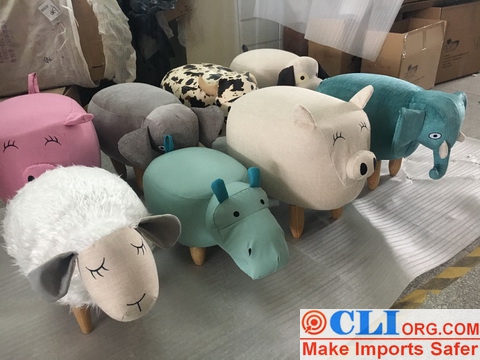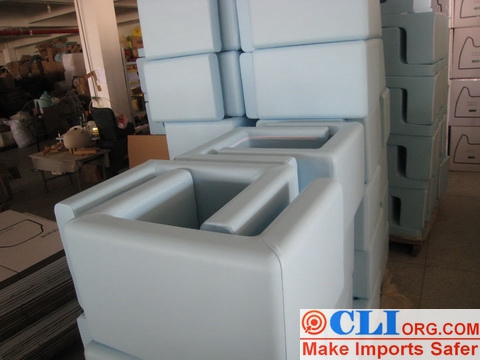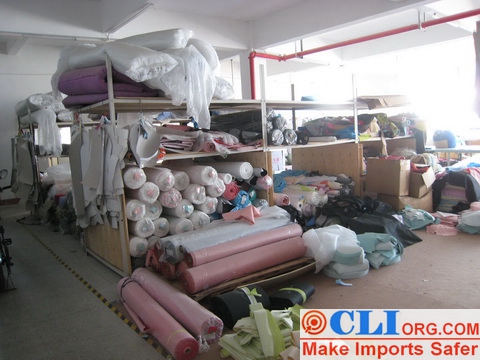The Survival of a Children’s Furniture Factory in Xiamen of China
By Scott Chin • 11/5 @ 8:22 • The Survival of a Children’s Furniture Factory in Xiamen of China已关闭评论
Two years later, I came back to this children furniture factory in Xiamen again. At that time, the reason why I was impressed by this factory was because the owner Tony positioned the product in mid-to-high-end children’s furniture. Although children’s furniture is relatively niche, consumers have high demand and high quality requirements. Therefore, Tony positioned his target customers in developed countries such as Europe, America, Japan and South Korea. One of the Korean customers used his unique marketing capabilities to incorporate advertising into a South Korean parent-child entertainment reality show. The program’s audience ratings were soaring that it quickly attracted a large number of consumers to inquire about the purchase channels of furniture.

This further shows that the market segment of furniture has begun to appear. And it is no longer limited to ordinary household furniture. Targeting the needs of specific groups of people is unique to the survival of children furniture factory.
In addition to the ability to judge the market trend, what else will affect the survival of the children furniture factory? Let’s take a look at it in detail:
Worker recruitment
At this stage, many young people are unwilling to work in factories for various reasons. And overall they lacks the ability to bear hardships and stand hard work. Xiamen is a city with a large foreign population, so most of the workers are from other cities. However, due to the impact of the epidemic, migrant workers in other provinces cannot go out and have to work locally. After time goes by, they gradually adapt to the local rules of survival and are reluctant to leave their hometowns. It is becoming increasingly difficult to recruit workers. Tony’s solution is to recruit workers from his hometown, because his hometown is in Quanzhou, more than 80 kilometers away from Xiamen. Many workers are willing to engage in such a job.

Operating costs
The operating costs of the factory are nothing more than labor costs, plant rentals and material costs. The size of Tony’s children furniture factory is about 30-50 people, and the workers are mainly turners and carpenters. Because the frame of children’s furniture is wooden, Tony’s requirements for carpentry are still relatively high. On the production line, you can see a skilled woodworker teaching new woodworkers one-to-one. This shows that the wages of woodworkers are still considerable, because compared with other traditional furniture industries, the skilled workman of children’s furniture have a certain technical content and premium space. Tony said that although the wages of workers are piece-rate, the wages of carpenters can reach 6000-8000RMB (890-1200USD), and the wages of woodworkers can reach 80-10 thousand RMB (1200-1500USD). He stated that wages already account for 30% of costs.

This children furniture factory is set up on the first floor of a building in an old industrial area off Xiamen Island. Although parking is difficult, the rent for the workshop has been increasing, and it is currently about 15 yuan per square meter (2.23 USD). It can be seen from the scene that the aisles are occupied by goods in this 3000 square meter factory. This shows that orders have increased and product categories have also expanded, but the configuration has not kept up. A new idea began to come to Tony’s mind…
When the global epidemic continues to ferment, people are starting to work from home. The demand for household products has increased significantly, which means that Tony’s children’s furniture has begun to enter more international markets. The increase in order volume could have brought high profits, but the raw materials for Chinese furniture manufacturing are becoming more and more expensive. In addition, in recent years, the Chinese government has focused on monitoring and implementing environmental protection policies, which has caused the price of packaging materials to rise sharply. Even so, Tony still insists on making mid-to-high-end children’s furniture and will never engage in low-end furniture. Pay attention to the quality control of children’s furniture. And implement the key points of each process in place, because he is convinced that children’s furniture with high quality will be welcomed by the market.
Manual Labor vs. Machine
A full-featured machine costs tens of thousands, or even hundreds of thousands. Tony had to consider using more manual labor. After all, a skilled worker is not prone to operating deviations, and he can still teach new ones. The effects of manual work are not completely replaceable by machines. Tony mentioned that a new sewing machine has added thread trimming function compared to before. And the price is even more than 1,000 yuan (150USD) cheaper. The new machine saves the workload of thread trimmers by hand. Tony focuses his labor on the most important lathes and carpenters, reducing costs to a certain extent.
Relocation
The rising costs have compressed profit margins, and Tony worried that he would lose his price advantage.Prices in turn suppress the scale of labor, and the marginal cost is higher with the loss of economies of scale.So labor becomes more expensive, and with limited space, it’s impossible to expand capacity. This is the problem Tony is facing,so the idea of moving the factory naturally came. Tony told me that he wanted to move the children furniture factory to Anxi, Quanzhou, because the factory rent is only 8-10 yuan per square meter (1.19USD-1.49USD). And the wages of workers can be reduced to 4000-6000RMB (600USD-890USD). Of course, it is not easy to make the decision to move the factory, because the cost of moving the factory is close to more than 30,000 US dollars!

Anxi in Quanzhou has a history of tea production for thousands of years and is mainly famous for tea. Every household has its own tea mountain, so they are not happy to work in the factory. As a result, Tony’s recruitment became more difficult, even harder than Xiamen. In addition, the management of local workers is relatively difficult, which is why I advise Tony to carefully consider moving the factory.
CLI Inspection’s Comments And Summary
In fact, Tony first started with steel-wood furniture and trading in Zhangzhou. Later, because of low profits, he began to make children’s furniture. After conducting market research, Tony found that there is relatively little competition in children’s furniture because this is a niche market in the furniture industry.Children’s furniture is actually a very niche product, and the buyer needs to have a certain financial strength. Therefore, compared with the traditional furniture manufacturing industry or factories, the pressure will be less.
However, as the situation of international trade changes, foreign exchange is often unstable. The pressure Tony is facing has risen sharply. At this moment, he needs to find a balance point, starting from each aspect that affects the cost, and find the entry point. Expand its own structure, consider long-term goals, and then solve the problem of production capacity. At the same time, by strengthening business capabilities and increasing orders, he can find a way to survive for children furniture factory.
This article is an original article for CLI Inspection, who is committed to providing high-quality product inspection technology and know-how sharing for global importers and retailers to make imports safer.
All rights reserved. The contents of this website provided by CLI Inspection may not be reproduced or used without express permission.
For reprint, please contact with CLI Inspection, thank you.
Scott Chin
Senior professionals in the field of quality inspection are committed to finding and sharing valuable experiences.
SEARCH
Email Subscribers
Recent Posts
- register-081823 08/18 @ 8:03
- A Few Tricks to Teach You How to Easily Buy Luggage Case Bags With High Cost Performance ? 04/20 @ 8:47
- You Can’t Imagine That A Big Brand Like KAPPA Will Find Serious Batch Problems During Inspection! 04/13 @ 9:08
- Folding Table: Technological Comparison Between Two Factories 04/6 @ 8:45
- Are You Still Worried About Clothes Damaged by Hangers? 03/29 @ 8:26
Recent Comments
Monthly Files
Catalogue
Tags
BLOG
- register-081823 08/18 @ 8:03
- A Few Tricks to Teach You How to Easily Buy Luggage Case Bags With High Cost Performance ? 04/20 @ 8:47
- You Can’t Imagine That A Big Brand Like KAPPA Will Find Serious Batch Problems During Inspection! 04/13 @ 9:08
- Folding Table: Technological Comparison Between Two Factories 04/6 @ 8:45
